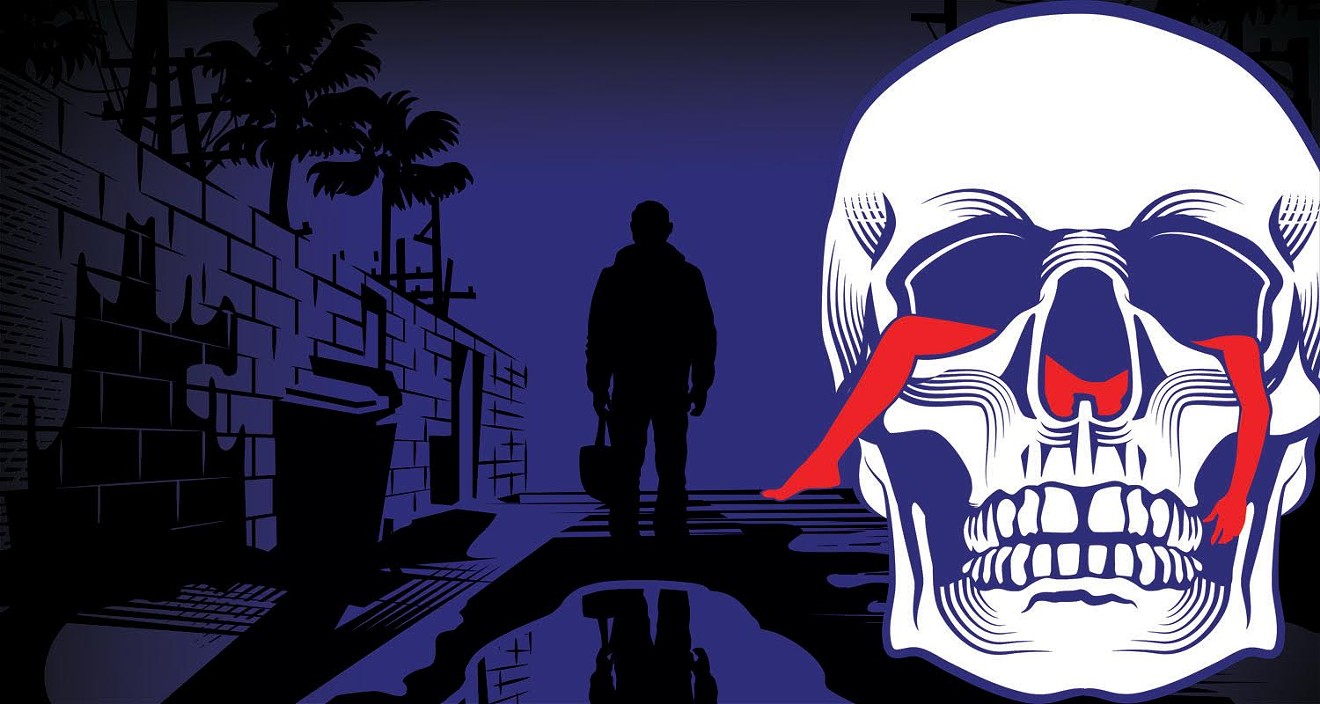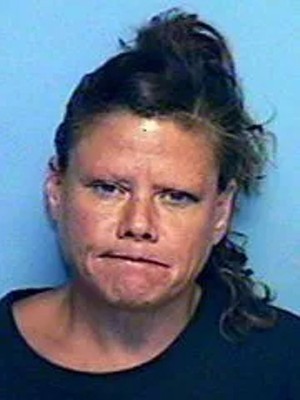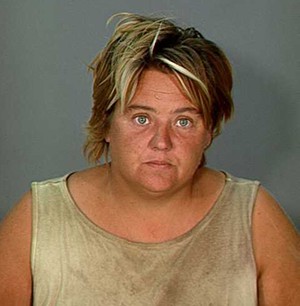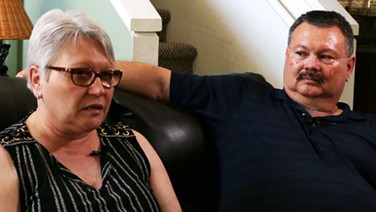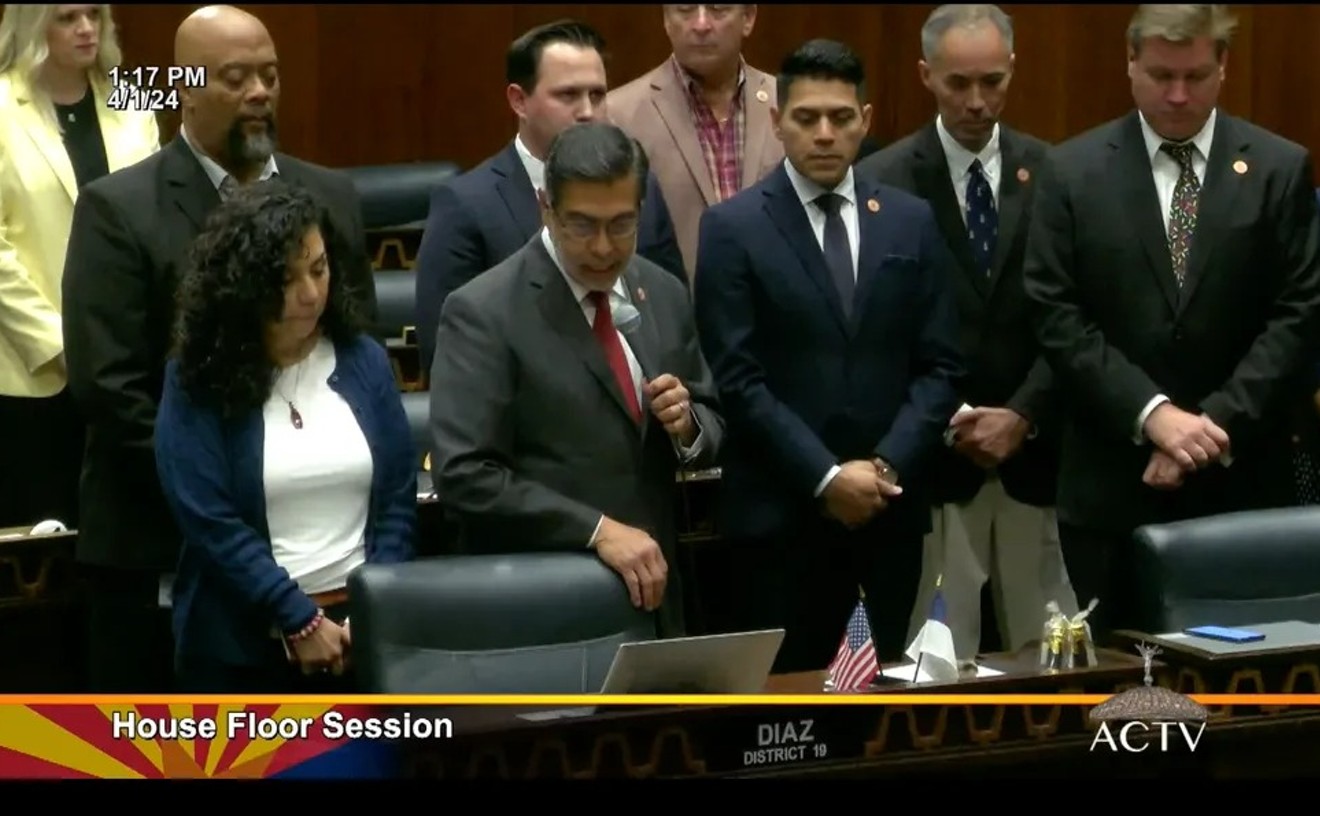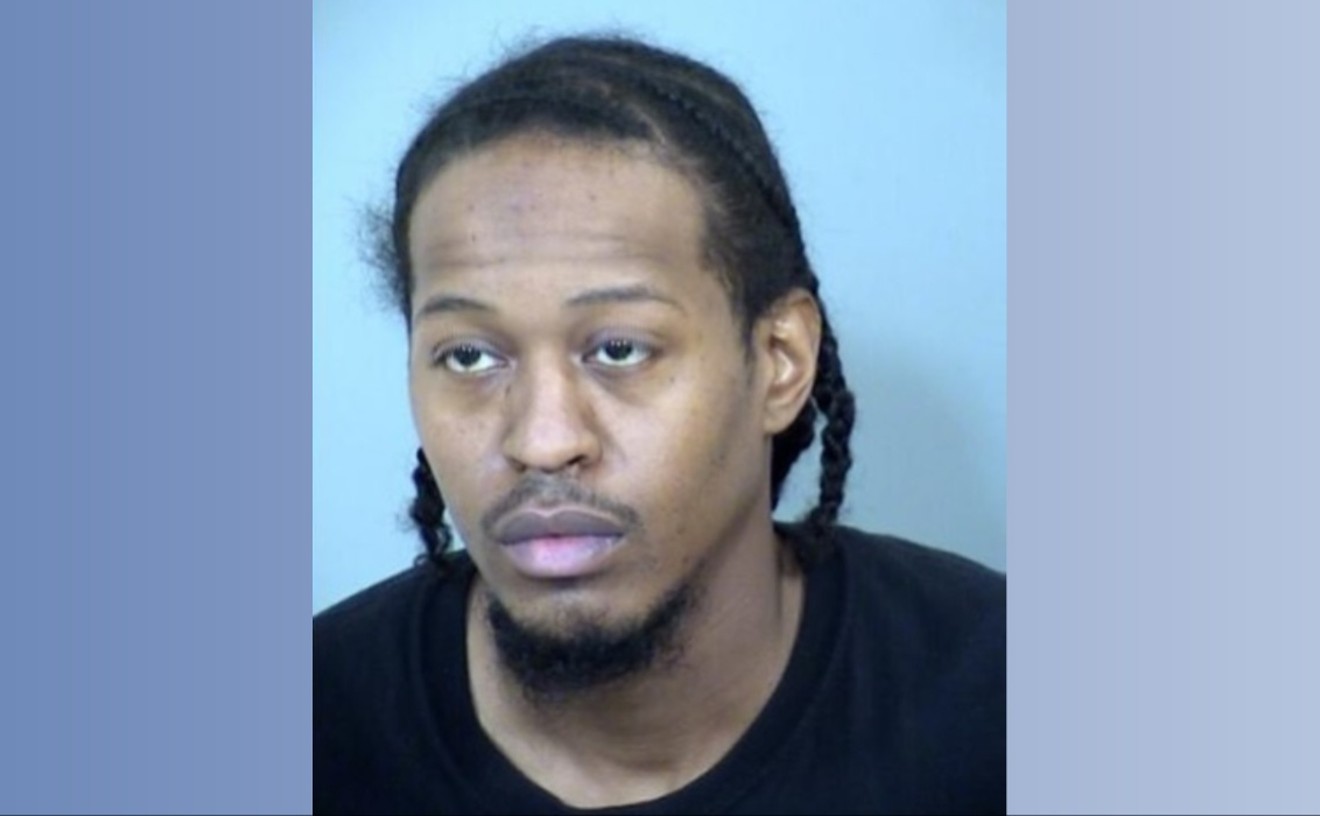CHAPTER 1: ONE GRUESOME NIGHT IN OCTOBER 2007
(First of two parts)
Sometime on Saturday, October 13, 2007, Gina Carol Guthrie locked the door to her room at the tawdry Sandman Motel, descended the stairs to the lobby, and adjusted her outfit in the mirror.
The tied-off black, short-sleeved shirt would draw looks.
The Sandman’s clerk watched her walk a few steps to the bus stop on West Van Buren Street near 29th Avenue in Phoenix. He never saw her again.
The bus took her a few stops west, past the big cemetery, back onto familiar streets. Tough streets, but her streets. The streets where her caseworker had dropped her off only the day before, following yet another bout with bipolar disorder.
Four miles away that day, Sandra Antoinette Jakubowski stepped out onto unfamiliar streets. Five days earlier, she was under lock and key at a state psychiatric ward in Mesa, not far from where she lived most of her adult life.
Now, alone, she was in an urban wasteland just off Seventh Street in Phoenix, between the boxcar sidings and the interstate. Jets from nearby Sky Harbor roared overhead.
Sandra needed money. She wanted a drink.
Los Arcos, the popular neighborhood dive on Mohave Street, was hopping. Across Mohave, the woman behind the metal grille at the the drive-up liquor store wouldn’t sell to Sandra. So she bounced back and forth across the street asking men to buy a lady a drink. A man from the neighborhood refused.
Down Mohave Street, amid condemned buildings and bulldozed gravel lots, dogs barked their warnings from behind chain-link fences.
Midnight was the last time anybody saw Sandra Jakubowski alive.
That Sunday morning, a man taking out the empties after a long party found her. She was naked from the waist down, lying in the gravel, dirt, and litter of an alley. Her body was 700 feet from Los Arcos, lying face up next to a black city garbage bin in the weeds.
Fewer than 17 hours later, a woman on her way to an early shift found Gina Guthrie’s body in an alley near Van Buren Street and 29th Avenue. She was half a mile away from the Sandman.
Gina was naked from the waist down, lying face down in the gravel. She lay next to a large black garbage bin amid the spilled paper wrappers and bottles. It was 4 a.m. in the cool, clear predawn of Monday, October 15, 2007.
Both women were homeless. Both battled addiction. Both were treated for depression. Both were strangled.
Neither case has been solved. Their deaths, like their lives, faded from memory. Ten years passed. Their cases, like many hundreds of others in Phoenix, went cold.
The Phoenix Police Department lists a backlog of almost 2,400 cold-case murders, defined as those with no fresh leads in a year.
“Phoenix is one of America’s cold-case capitals,” says Tom Hargrove, executive director of the Murder Accountability Project. A city this size should have half as many, he says.
He and his Virginia-based nonprofit compiled the largest database of murders in the country. It was assembled from the FBI’s Supplemental Homicide Report and from lawsuits his group filed to compel agencies to report cases. The database spans 40 years from 1975 to 2015.
It lists 732,000 murders. Of those, 214,000 remain unsolved. No suspects named.
That means nearly one killer in three is not caught. Phoenix and Arizona are no different, a Phoenix New Times analysis of the data shows. Phoenix ranks in the middle of the pack for solving murders among departments that investigated more than 1,000 homicides since 1980.
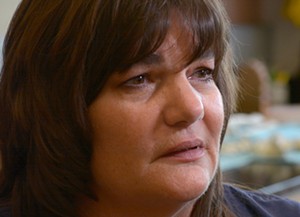
Forensic anthropologist Dr. Laura Fulginiti: “The public has an unrealistic expectation of what we can do. They think: ‘Why can’t you just solve it in an hour? They do it on TV all the time.’”
Wordslinger LLC
This, despite important advances in forensic science, especially DNA. Despite countless new and better technologies and techniques. Even though the public is more informed.
“Misinformed,” detectives and forensic anthropologists say.
"The public has an unrealistic expectation of what we can do,” says Dr. Laura Fulginiti, forensic anthropologist at the Maricopa County Medical Examiner’s Office. “They think: ‘Why can’t you just solve it in an hour? They do it on TV all the time.’”
“They don’t understand the grinding nature of what we do. It’s little puzzle pieces, put together, put together, put together until you finally have a picture,” she adds.
The picture is distorted by a steady diet of “true crime” shows. We are led to believe serial killers run amok. The murder rate is skyrocketing. Police always get their man. Science can solve any riddle with the click of a mouse.
The ghosts of Gina Guthrie and Sandra Jakubowski tell us something else.
The homicide clearance rate fell nationally, but so did the murder rate. The U.S. murder rate peaked in 1993, at the apex of the nation’s crack cocaine scourge.
But Phoenix’s murder rate kept climbing, peaking in 2007. That year, Phoenix police also logged their worst rate of closing murder cases — 52 percent.
The sweltering summer before, the department dedicated huge resources to catch two sets of serial killers — known widely as the Baseline Killer and the Serial Shooters — who terrorized the city, killing at least 17 people. And just this year, Phoenix police said they caught the man they call the Serial Street Shooter, who hunted people on the streets of Maryvale and central Phoenix. The suspect is charged with nine murders since 2015.
The city’s spate of prolific serial killers is also out of step with the rest of the country.
For a quarter century, Mike Aamodt and his team at Radford University in Virginia have catalogued nearly 4,800 known serial killers. It’s the largest compendium of serial killers ever amassed.
Aamodt’s team drills into exacting detail of more than 130 variables, everything from the IQ of the killer to how he met his victim. “He,” because 90 percent of serial killers are men.
The patterns buck the classic Hollywood stereotype of the deranged, white male loner.
“It turned out it was only accurate about 12 percent of the time,” Aamodt says. “Maybe what we think we knew about serial killers wasn’t necessarily all that accurate.”
The worst year for serial killers nationally was 1987. That year, 189 killers murdered two or more people in separate places and times, Aamodt’s database shows.
Why did Phoenix lag so long?
Some experts suggest it’s because Arizona is a fast-growing state. But similar states, like Nevada and Florida fit the national norm. Arizona is the gateway for smuggled drugs and people from Mexico. But Texas, California, and New Mexico also look like the rest of the country.
Something very unusual is afoot in Phoenix. Experts can’t explain why there have been so many serial killers here in the past decade.
“I don’t think anybody has the answer,” says Sergeant Jonathan Howard, spokesman for the Phoenix Police Department.
Nor does anybody have the answer to who killed Gina Guthrie and Sandra Jakubowski.
CHAPTER 2: A MOTHER, A BEAUTICIAN; THEY HAD LIVES
Nothing predestined the fates of Gina Guthrie and Sandra Jakubowski.
Their lives took tragic turns that put them in the trash-filled Phoenix alleys where they were found dead and alone in October 2007, four miles and 17 hours apart. Gina was a mother of three. Sandra was a beautician. They fought their demons and the demons won.
Little is known about Sandra. Her brother politely declined interviews on behalf of the family. His mother already had been through too much.
A friend remembered “Sandy” in a condolence book as “a young woman with so much wit and determination.”
Sandra moved to the East Valley from the Chicago area before her depression took hold.
In 2005, she filed for bankruptcy in federal court, claiming she owed nearly $21,000 in unpaid credit card bills and back rent. She listed $585 to her name, most of it furniture and a couple of TVs.
She declared she was single and disabled, living off of $628 month in government assistance. She needed $731 a month to make it at her Power Road apartment in Mesa.
She wound up on the street. By 2007, she was committed to a psychiatric ward at the Desert Vista Behavioral Center. Five days after her last recorded day there, somebody killed Sandra Jakubowski.
Much more is known about Gina Guthrie.
She had always lived a troubled life, but found brief moments of happiness.
She wanted her kids, but her mother, her illness, and her choices made that impossible. It tormented her. Street life became her true home. And it killed her.
“Gina, my sister, was a soft-spoken, quiet, very kind, loving person. She was not a bubbly outgoing personality, but she was a very loving, kind individual. Unobtrusive. She didn’t cause a lot of problems. She just loved life. She loved kids,” her brother, Kevin Earley, says.
He and Gina moved from Virginia in the early 1970s. They lived in a chaotic home in Maryvale, where their mother, fueled by alcohol, took aim. With her, it was the bottle and the belt. Sometimes more.
“She laid down the law,” Earley says.
He kept his head down and his mouth shut. He got out of the way and, later, the house. His younger sister took a different path.
Hard drugs helped her “try to forget, try to enjoy life,” Earley says.
By 14, she was taking angel dust, windowpane LSD, and meth. Soon, she had two kids by different men. Earley told her to be careful.
Their mother told everybody Gina would never add up to anything. It wounded her.
“It almost seemed like she preferred this lifestyle or any lifestyle that was outside of the thumbprint of my mom,” Earley says. “So being out on the street seemed more preferable to her than being at home.”
Earley gave his sister money, sometimes a lot, but he knew it would go to waste.
By the early 1980s, Earley met and married Lois and they built a family. Gina was doing better. She had met Guy Guthrie, a carpet cleaner. She got off the street and lived the life of a homemaker.
Right away, Lois Earley “liked her a lot.” They bonded. Gina would confide in Lois.
But Gina’s peace unraveled quickly amid nasty rumors about her husband. It was never clear if Gina’s mother was spreading her poison. Or if Gina was delusional. At the time, nobody knew, not even Gina, that she was bipolar.
The marriage fell apart in 1985. Gina kept their daughter, and a 10-year custody battle ensued. Guy Guthrie finally prevailed in the mid-1990s, court records show. He told the court his ex was “completely unfit” to care for a child. Guy Guthrie moved away. He could not be reached on listed phone numbers and social media accounts.
Gina was already back on the street, for good. Her mother persuaded Earley to give her guardianship of her grandchildren. Earley knew his mother was exerting control, but his sister was in no shape to care for them.
Besides, the Earleys now had their own daughter to care for. They drifted from Gina. But she would call and talk about wanting to get the kids back. Her brother told her she had to clean up first.
The wound festered. The illness deepened. The meth tugged harder.
By the early 1990s, other calls started coming. Gina was in jail. She was in rehab. She was back in jail. Again. And again.
“I just remember seeing her there, sitting at a table, and just being totally shocked,” Kevin Earley says.
Homelessness and meth addiction were not new topics, but now they heard a new word. Prostitution.
Gina told them about it during a visit to Desert Vista.
“I was asking her: How you supporting yourself? You’re on the street. What are you doing? I probably blanked it out because she is my sister,” Kevin Earley says. “Oh, I felt terrible. Like I probably caused part of it, you know, by not being around.”
Lois Earley remembers how blunt Gina was.
“I was taken aback by how matter of fact it was, but Gina was like that about everything,” she says.
In 2004, Gina told them for the first time she was bipolar. For Lois Earley, it all clicked.
“I believe that it was the mental illness that made her what she was. I believe that she was a prostitute and a drug addict because,” Lois Earley says, “she had nowhere to go.”
She blames the mental-health system for Gina’s death.
“They would tell her, ‘Yes, you have a mental illness, but you’re also addicted to drugs and you’re a prostitute you need to stop doing those things and take care of yourself.’ As if somebody who is mentally ill can do those things,” Lois Earley says. “It doesn’t work when there’s something wrong with your brain.”
Gina fled rehab repeatedly.
“So you know you have this mentally ill, psychotic person who’s able to come and go as she pleased and we wonder why she ended up where she ended up,” Lois Earley says.
She broke the news of Gina’s death to her husband.
Kevin Earley bottled his feelings, but the news tore at him.
“I didn’t show any emotion at all. I was angry. I was helpless. I hated to be thinking that I was right that something was going to happen to her if she’s on the street,” he says. “And sure enough it did.”

Sandra Jakubowski was last seen in the vicinity of Los Arcos, a neighborhood bar on Mohave Street just east of Seventh Street.
Wordslinger LLC
On Sunday, October 14, 2007, in a part of Phoenix where cars slow down to cast long, hard looks at strangers, it was the morning after.
The morning after anyone in the neighborhood saw Sandra Jakubowski alive.
The morning after Chuey Ortega threw a bash on the front porch of his bungalow at 909 East Mohave Street. About 10 friends, neighbors, and relatives reveled in a mild Saturday evening. Most were from the block, some up from southern Arizona. They were all men. They drank, ate ceviche, and drank some more on into the night.
At around 6:30 p.m., Ortega took his family to a piñata party nearby. Ortega’s uncle, Luis Ortega, stayed behind and kept the party going. He had lived across the street for 16 years and knew the neighborhood well.
Down at the end of the block, Sandra had been on the move, but it’s not clear where she stayed after she was released from the Desert Vista Behavioral Health Center, 13 miles away in Mesa. The nearest hotel was the EZ-8 just across Seventh Street. The clerk there says he found no record of anyone named Jakubowski checking into a room in October 2007.
She’d been spotted the previous few days.
Luis Ortega’s neighbor Dan Daniels had seen her walking down the street, talking to herself. The clerk at Star Liquor had seen her hanging around the drive-up.
She was back in the neighborhood, and broke. The clerk inside the cage there told her to get lost. Right across the street, a knot of people hung around outside Los Arcos. She asked some men to spot her for a drink.
Shortly before midnight, she went back in front of Star Liquor and asked Dan Daniels, who had taken a break from Chuey’s party down the street. Daniels said no. He watched Sandra bounce back to Los Arcos. Then he headed home, past the mechanics’ shops and empty lots on Mohave.
Luis Ortega went the other way. Around 11:30 p.m., he went to Los Arcos. There, he later told police, he danced with the waitress. He walked home and went to bed around closing time.
Chuey Ortega returned from the piñata party with his wife and kids around 9 or 9:30 p.m. They drove up the gravel alleyway behind their house, unlocked the chain-link fence at the back of their yard, pulled inside, parked the car, and locked the fence.
They noticed nothing unusual.
Chuey Ortega went to the front porch and cracked another cerveza. Guests drifted in and out, but most stayed until 11. His friend Miguel Chavira-Leal, up from Rio Rico, lasted until 2 a.m., and then crashed out.
After he woke that Sunday morning, Miguel helped shift all the empties. Chuey pushed a wheelbarrow full of them through the gate just after 10 a.m.
That’s when the two friends saw her: Sandra Jakubowski lay face up next to the trash can.
She was 5 feet tall, with hazel eyes and shoulder-length brown hair. She weighed 182 pounds and wore a white tank top, blue swimsuit, green shorts, and sandals. She was naked from the waist down.
Blood smeared across her chest. Bruises, cuts, and scrapes marred her face and torso. Numerous deep bruises littered her scalp. Signs of a bashing.
Crusty brown abrasions appeared on her left nipple and circled her right one. Signs of trauma showed on her genitals.
Telltale bruises lined her neck. Later, the autopsy found broken cartilage in her throat. Somebody had raped her and choked her to death.
Nobody saw it. Nobody heard it.
The condition of Sandra’s corpse suggested she’d been there a while.
Police interviewed some men who had been at the party.
Dan Daniels, the neighbor across the street, immediately asked about the identity of the dead woman. Police noted in the report, “he asked if she was a short, heavyset, white lady with big tits.”
Daniels described the woman from the liquor store, a little taller and heavier than she really was, and wearing a peach tank top, not white. He told police she was between 42 and 44 years old.
Sandra was 42.
Luis Ortega asked to view the dead woman’s face. Maybe he had seen her at Los Arcos. He said he saw nothing on his walk home from the bar. He told police somebody from the neighborhood must have killed her.
Officers knocked on doors. Nothing.
Two homes, one at the church next door, another a shack just opposite the alley, looked directly onto the crime scene, but they were both vacant.
Sandra Jakubowski left this world unnoticed.
Seventeen hours after Sandra was found and four miles away, Gloria Molina Cruz backed her car out her parking slip at the back of her small brick apartment at 2837 West Melvin Street. She was on her way to start an early Monday-morning shift.
Cruz saw a woman lying face down in alley, next to the big black trash bin. She was used to transients and prostitutes there. She nudged the woman with her foot. No response. At 4:06 a.m., she called 911. Four minutes later the police arrived.
They found a woman who looked like she had been in a fight: cuts, scrapes, and bruises everywhere. Her head had been smashed with something hard. There was no obvious damage to her throat, but tiny burst blood vessels in her eyes showed she had been strangled, too.
Around the areola of her right breast, medical examiners found a small cluster of crusty brown abrasions.
Cruz saw and heard nothing before she went to her car.
Early into the investigation, police contacted a neighborhood prostitute. An hour earlier, she had been on the corner of 29th Avenue and Van Buren Street, about 200 feet away.
She told police she saw a large white van with V-shaped trim back out of the alley and drive north up 29th. She said it looked like a Ford Econoline with Arizona plates. She didn’t see the driver.
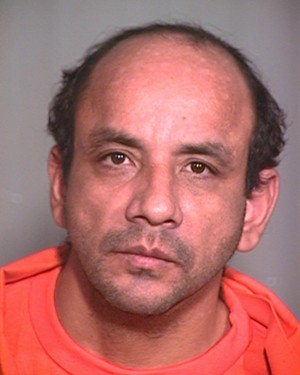
Johnny Moron. He’s serving a seven-year sentence in Yuma on a drug charge. He was near the scene where Guthrie’s body was found.
Arizona Department of Corrections
Police pulled open the zipper. Moron saw a 5-foot, 3-inch tall woman with hazel eyes and greying shoulder-length brown hair. She weighed 142 pounds. Right away, Moron identified the body.
Fingerprints later confirmed it was Gina Guthrie, age 44.
Police knew her well. They had repeatedly arrested her for prostitution, drug charges, and general disturbances. The autopsy said she looked older than her years. Thirty years on the street had turned her face to leather.
Moron said Gina hung out around 33rd Avenue and Van Buren, where she lived on the streets with her friends. Moron had last seen her three days earlier.
Moron declined a New Times interview request. He is serving seven years in prison near Yuma on a drug-dealing conviction.
Detectives had other leads to follow. Their files had plenty on Gina: arrests for prostitution and assault in 2006 around the corner from the rehab clinic on East Van Buren Street where she stayed, and arrests in 2006 and 2007 near 27th Avenue and Adams Street, for public urination and flicking a cigarette at a cop and telling him to “fuck off,” a quarter mile away from where the body was found.
Gina never listed any family when police picked her up. Officers tracked her to a clinic and then to a caseworker, Iola Reed, at Magellan Health Services. Reed told detectives she had seen Gina that Friday afternoon, three days before.
Gina came to pick up a $100 disability check and asked Reed to drive her to 35th Avenue and Van Buren, so she could cash it. Reed drove her to the Sandman Motel, less than two miles to the east, checked her in, and then dropped her off where she requested. She never heard from her again.
Across the street from the check-cashing store, cameras at the Chevron station recorded a suspicious incident the night after Gina died.
The attendant, Anthony Melendez, later told police a woman approached his booth and begged for protection. She claimed a man had tried to choke her and take her panties. The attendant saw a man riding a bicycle and another man he described as “a bum” come to the station.
The man on the bike was drunk, agitated, and spewing a rant about how he had to stop the woman being a prostitute and the other man being homeless. He told Melendez that if nothing was done “he’d take them all out.”
Melendez didn’t recognize the man, but he had seen the woman dropped off by cars on the corner many times. She told him the man bragged to her that he had strangled a woman behind Jimmy Jacks, a burger joint just to the east. He’d taken clothes and cut her breast, she said.
After the outburst, the man peddled east down Van Buren, back toward Jimmy Jacks and the spot Gina died.
Melendez told police other prostitutes were talking about Gina’s murder and the death of another prostitute who had been hit by a car in front of the gas station. They had stopped hanging around as much, and were either spooked or cold, he told police. It was now early December.
Police pulled the 20-minute security footage. It showed a tall, heavy, white man on a mountain bike, carrying a bag. The image was too grainy for detectives to identify anyone, including the scared prostitute.
Not much has changed on that milelong stretch of West Van Buren Street. Strip malls line the blocks, selling cheap food, cheap booze, and cheap tires. Just off the drag are trailer parks. At the shelters, you can get a hot bowl of soup or a cup of cold redemption.
Neighbors come and go every six months and never talk to each other, or anyone else. Men and women with deep tans and tattered clothes roam the streets, some aimlessly, some in need of a score, others a john.
Younger men ride low bicycles, carry small duffel bags, talk on cellphones, and ask strangers why they are there.
In the spot Gina Guthrie died, an empty condom wrapper rests in the gravel. The place reeks a unique sweet-and-putrid blend of landfill, sewer, and fast-food kitchen. Not 700 feet away, in the alley behind Jimmy Jacks, a neighborhood hangout, two hookers and a junkie sit in a pile of trash, lean against a wall, and shoot up. Thirty feet away, somebody has erected a lean-to from cardboard and Styrofoam.
Back in 2007, police went to the murder scenes of two troubled women. Two women who had been strangled. Both had cuts around their right nipple. Both white. Both in their 40s. Both with hazel eyes and brown hair. Both on the street. Both with drug addictions. Both with cocaine in their bloodstream. Both battling mental disease. Both discarded next to the trash. Both forgotten.
Around town, and not far away, other women like them were dying.
CHAPTER 4: CLUSTERS OF DEATH
Criminologists call them clusters.
Some of the most pioneering work to find clusters is not being done in police squad rooms, but in universities or by independent investigators like Tom Hargrove.
The FBI tracked 31 variables in the 732,000 murders the bureau has cataloged since 1975. Those factors include the race, ethnicity, age, and gender of the victim, the weapon used and the circumstances of the murder.
Hargrove teased patterns from the data with a powerful statistics program normally used in research labs. He tried different combinations of factors, and gave each cluster of similar crimes a unique number.
It’s like a zip code for murders. Hargrove calls it his “Dewey Decimal System of death.”
All the shootings of black men in their 20s, for instance, got one number. Strangulations of white women in their 40s got another. Identical crimes in different cities got their own unique numbers.
Hargrove focused on those with abnormally low solve rates and ranked them. These were the clusters of unsolved killings.
He tested the system. It predicted the handiwork of Gary Ridgeway, the Green River Killer, who confessed to killing 49 women in the Pacific Northwest during the 1980s and ’90s.
Hargrove’s computer modeled a cluster in Los Angeles, the largest in the country. The Los Angeles Police Department formed the Southside Killer Task Force to crack cold cases. It turned out there were five or six serial killers, all unrelated, preying on women there.
The second-largest cluster was in Phoenix, Hargrove told police here in 2010.
Phoenix detectives here were grateful for the data, but unconvinced the killings were related.
“Phoenix was one of my failures,” Hargrove says. “I still think there were (unsolved) serial killings in Phoenix.”
But he couldn’t prove it. New Times picked up where he left off.
We refined his clusters, looking more discretely at gender, narrower age groups, weapon, and location. We ignored any cluster in which police solved more than a third of the cases, half the average rate.
In Arizona, 10 clusters remained, six in Maricopa County. The largest was a group of 270 men between the ages of 26 and 50, shot by an unknown type of firearm. Little more than a quarter of those murders were solved.
Police were slightly better at solving murders of 40 women close to the same age killed by unknown means. In one group, of 20 men between 18 and 25 killed by unknown means, only 10 percent of those cases were solved.
But these are raw and crude snapshots, taken over the course of 40 years. We dove deeper into city-by-city statistics, looking at race and shorter slices of time.
Two clear patterns in Maricopa County jump out from the FBI data. In one cluster, 43 women were shot to death, and in another, 48 women were killed by unknown means. Fewer than a third of their killers were caught.
In Phoenix, four white women between the ages of 35 and 50 were strangled from 2006 to 2009. Police solved none.
Gina Guthrie and Sandra Jakubowski were among them.
The Phoenix Police Department’s list of cold-case murders, released under a public records request, reveals an even more chilling pattern.
Between 2006 and 2009, six women were murdered in similar fashion. Three of the other four were prostitutes. One was found naked in a park filled with a cocktail of drugs. Two were transient. One had a meth habit. One had a history of mental illness.
One was last seen alive five blocks from where Gina was dumped. Another was killed one block off Van Buren Street near a park frequented by prostitutes, pushers, and homeless people. Gina stayed at a different motel five blocks away the year before she died.
That does not mean the killings are linked. A cluster only shows that people of a similar profile were killed by similar means. It indicates of the possibility of a serial killer, not proof.
But Hargrove, seeing the details for the first time, is convinced of the link.
“Serial murder is more common than we ever want to believe. And I have no doubt whatsoever that there are uncaught serial killers still in Phoenix,” he says.
So were the deaths of Gina Guthrie and Sandra Jakubowski the work of yet another serial killer in Phoenix?
We may never know.
PART 2: HOW MURDER CASES GO COLD

